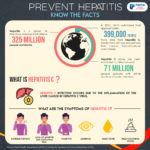Hepatitis C: Know the facts
Hepatitis is a group of infectious diseases that affects 325 million people worldwide. Hepatitis C alone has been estimated to infect around 71 million people globally with either acute or chronic infection. Most individuals that have chronic infection will develop cirrhosis or liver cancer.2, 3, 5, 6 In 2016, WHO estimated that approximately 399,000 people have died from hepatitis C, mostly from cirrhosis and primary liver cancer (hepatocellular carcinoma).1
What is Hepatitis C?
Hepatitis C infection occurs due to the inflammation of the liver caused by hepatitis C virus.3
What are the symptoms of Hepatitis C?
Individuals infected with hepatitis C are usually unaware that they are infected as it occurs with minimal to no clinical symptoms and are non-specific in most cases.7
When symptoms are present, they include extreme fatigue, jaundice, vomiting, dark urine, pale-coloured stool, loss of appetite and abdominal pain.1
What causes Hepatitis C?
Hepatitis holds a great concern due to the burden of death it causes and its potential of causing an outbreak and epidemic spread.
Hepatitis C is mainly transmitted through parenteral contact with contaminated blood such as from infected mother to child at birth, through sharing medical equipment (i.e. needle and syringe) and personal items (i.e. razor and toothbrush) and less frequently through unprotected blood-to-blood sexual contact with an infected person.1, 3, 5, 6, 7, 8
Who gets Hepatitis C?
Individuals at risk of hepatitis C are those in the healthcare profession, having multiple sexual partners and intravenous drug abusers.1, 8
Most cases are due to unknown origin which means an individual does not need to be included in a high-risk group in order to be infected with a hepatitis virus.
How is Hepatitis C diagnosed?
Since hepatitis C infection is usually asymptomatic, very few individuals are diagnosed and may have developed chronic hepatitis C infection which can lead to serious health problems including secondary to serious liver damage. Hence, it is important for an individual to do early screening to prevent the advancement of the disease.1, 3
Hepatitis C infection is diagnosed by testing for anti-hepatitis C virus antibodies with a serological test which identifies individuals that have been infected with the virus.
After an individual has been diagnosed with hepatitis C virus infection, an assessment of the degree of liver damage (fibrosis or cirrhosis) will be made through liver biopsy.1
The degree of liver damage is done to be used as a guide for making decisions for the management and treatment of the disease.1
In conclusion, hepatitis C infection is preventable, treatable and curable. Most individuals affected either lack prevention, testing or treatment.1 Hence, early screening and detection is an important step to prevent the progression to chronic infection (cirrhosis or liver cancer) and to reduce liver-related morbidity and mortality.6
Source:
- Hepatitis C. (2017, July 9). World Health Organization. https://www.who.int/news-room/fact-sheets/detail/hepatitis-c
- World Hepatitis Day 2019. (n.d.-a). World Health Organization. Retrieved July 24, 2020, from https://www.who.int/campaigns/world-hepatitis-day/2019
- What is Viral Hepatitis? (n.d.). Centers for Disease Control and Prevention. Retrieved July 24, 2020, from https://www.cdc.gov/hepatitis/abc/index.htm
- World Hepatitis Day — July 28th. (n.d.). Centers for Disease Control and Prevention. Retrieved July 24, 2020, from https://www.cdc.gov/hepatitis/awareness/worldhepday.htm
- (İskender, G., Mert, D., Çeken, S., Bahçecitapar, M., Yenigün, A., & Ertek, M. (2020). Hepatitis C screening and referral for further investigation and treatment in a tertiary care hospital. The Journal of Infection in Developing Countries, 14(06), 642-646.
- Guss, D., Sherigar, J., Rosen, P., & Mohanty, S. R. (2018). Diagnosis and management of hepatitis C infection in primary care settings. Journal of general internal medicine, 33(4), 551-557.
- Mohd Suan, M. A., Said, S. M., Lim, P. Y., Azman, A. Z. F., & Abu Hassan, M. R. (2019). Risk factors for hepatitis C infection among adult patients in Kedah state, Malaysia: A case–control study. PloS one, 14(10), e0224459.
- Ghany, M. G., Strader, D. B., Thomas, D. L., & Seeff, L. B. (2009). Diagnosis, management, and treatment of hepatitis C: an update. Hepatology, 49(4), 1335-1374.





